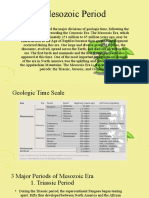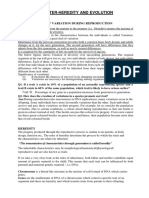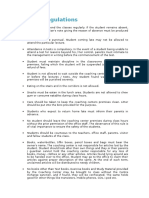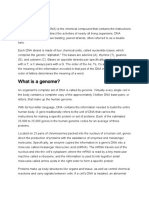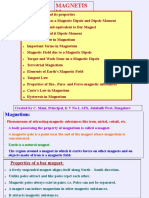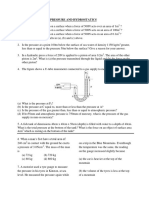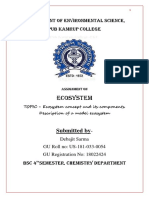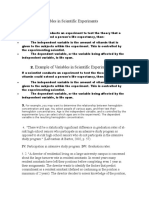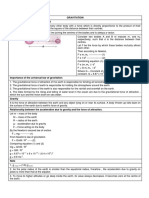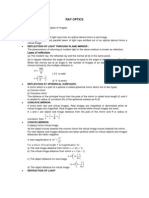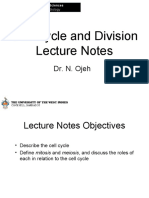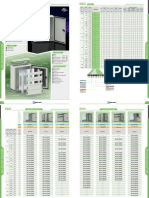Mitosis Meiosis Notes
Mitosis Meiosis Notes
Uploaded by
Sophia CookCopyright:
Available Formats
Mitosis Meiosis Notes
Mitosis Meiosis Notes
Uploaded by
Sophia CookCopyright
Available Formats
Share this document
Did you find this document useful?
Is this content inappropriate?
Copyright:
Available Formats
Mitosis Meiosis Notes
Mitosis Meiosis Notes
Uploaded by
Sophia CookCopyright:
Available Formats
Mitosis and Meiosis
Glossary
TERM DEFINITION
asexual reproduction a type of reproduction in which offspring receive all their genetic material from one parent
sexual reproduction a type of reproduction in which the offspring inherits half of its genetic information from each
parent
genetic variation the number of different alleles available in a population of organisms of the same species
gene an area of DNA that codes for a protein or certain nucleic acids
sperm a male reproductive cell; a gamete
egg a female reproductive cell; a gamete
mitosis a type of cell division that yields two diploid daughter cells
meiosis a type of cell division that yields four haploid daughter cells
chromosome a strand of DNA that contains genes and is located in the nucleus of a cell
cell cycle a series of events that involves the growth and division of a cell
Objective
use a model to illustrate the role of mitosis and meiosis in producing and maintaining complex organisms.
In this lesson, you will _______________________________________________________________________
_________________________________________________________________________________________.
Types of Reproduction
offspring
The ability to create __________________ is a characteristic of all living things. Organisms use a variety of
methods for reproduction. Some species can use more than one method, depending on environmental
conditions.
Asexual Reproduction
• Asexual reproduction requires one parent two parents.
• The offspring is genetically identical to distinct from the parent(s).
• find
One advantage is that the parent organism doesn’t need to ________ a ________.
___ mate
• One disadvantage is higher lower genetic variation in the population.
Copyright © 2019 Edmentum Inc. All Rights Reserved
Types of Asexual Reproduction
Type Outcome Notes
2
______ genetically used by single-celled eukaryotes
identical daughter for reproduction
cells used by multicellular organisms for
growth and repair
2
______ genetically used by prokaryotes for
identical daughter reproduction
cells
one genetically detach
may gradually _____________ to
identical outgrowth, become an independent cell or
or “bud” attached
remain _________________ to the
parent cell
vegetative one genetically certain specialized parts of the
propagation
identical plant leaf
plant, such as the ________, tuber,
root
or ________, can be grafted or
planted and grown into a new
plant
regeneration a replacement body generally not a mechanism for
part or a new producing offspring
organism
Copyright © 2019 Edmentum Inc. All Rights Reserved
Sexual Reproduction
• Sexual reproduction requires one parent two parents.
• The offspring is genetically identical to distinct from the parent(s).
• time
One disadvantage is the ________ energy
and ____________ it takes to find a mate.
• One advantage is higher lower genetic variation in the population.
adapt
Greater genetic variation in a population means that population is better able to __________ to changes in
environmental conditions. Some species can reproduce both sexually and asexually. Bees, for example, can
parthenogenesis
reproduce sexually or through __________________________________, in which a zygote is created without
fertilization of the ovum by a sperm.
Cell Division
Cell division is crucial for the reproduction, growth, and development of organisms.
Mitosis and the Cell Cycle
division
Mitosis is a type of cell __________________ identical
that produces two genetically __________________ daughter
replace
cells. Humans have specialized cells that perform mitosis to ______________ repair
and ____________ organs and
structures
tissues and to build new ____________________ grows
as the body ____________.
Mitosis is part of the cell cycle for diploid cells. The
daughter cells are also diploid; therefore, they have the
same number of chromosomes as the parent cell.
Interphase
Interphase is the part of the cell cycle when the cell
grows and prepares for cell division. It has three
phases:
▪ G1 phase: The cell grows and makes proteins for
replication
DNA ______________________.
▪ S phase: The cell grows and duplicates its DNA.
▪ G2 phase: The cell grows and makes proteins for
mitosis
______________.
Copyright © 2019 Edmentum Inc. All Rights Reserved
Mitosis and Cytokinesis
• Chromatin is a relaxed form of ______.
DNA
duplicate by the end
• Chromatin and organelles ____________
interphase g2
of this phase.
• DNA condenses into _____________
tightly coiled
_____________
chromosomes
______________________ made up of two sister
prophase chromatids
____________________.
spindles
• Mitotic ______________ form, creating microtubules.
• Microtubules attach to the ____________________
centromere of
each chromosome from each pole of the cell.
metaphase
center
• Chromosomes align in the ____________ of the cell.
• Microtubules shorten and pull the ______________
sister
chromatids
____________________ to opposite poles of the cell.
anaphase • The cell elongates.
• A nuclear ________________
envelope forms at each pole.
chromosomes
• __________________ chromatin
uncoil into ________________.
telophase • The microtubules disappear.
• Animal cells: The cell membrane pinches in, forming a
furrow where the cell divides.
cytokinesis cell
• Plant cells: Cytoplasm is divided by a _______
plate
_________, cell
which later forms the new ________
wall
________.
Regulation of the Cell Cycle
proteins
Cyclins are ________________ that regulate the cell cycle. During the cell cycle, three checkpoints ensure the
cell is growing and preparing for mitosis correctly:
▪ size
G1 checkpoint: The cell checks for cell ________, DNA ____________, and growth factors.
▪ doubled
G2 checkpoint: The cell checks whether DNA has ________________ undamaged
and is ____________________.
▪ microtubules
M checkpoint: The cell checks whether the ________________________ have attached to the
centromeres
____________________. metaphase
This check occurs at the ____________________ mitosis
stage of ______________.
Copyright © 2019 Edmentum Inc. All Rights Reserved
Stem Cells
unspecified
Stem cells are ________________________ specialized cells
cells that can later form ________________________ upon
differentiation
_______________________________. They can divide mitotically to produce similar unspecified cells.
Meiosis
• occurs in cells that produce ____________
gametes in sexually reproducing organisms
• begins with a diploid (2n) haploid (n) parent cell
• produces four diploid (2n) haploid (n) daughter cells
Meiosis I: 1 diploid cell → 2 haploid cells
interphase I • DNA replicates.
• Organelles duplicate.
• DNA condenses into _______
tightly coiled
___________
prophase I chromosomes
_________________.
• ____________________
homologous chromosomes align
and cross over.
• Microtubules from each poleform
mitotic ________________ connect to one
metaphase I
chromosome of the homologous pair.
• Homologous pairs align at the
center
______________.
• Homologous pairs __________________
separate from
anaphase I
each other.
• Chromosomes move toward ______________
opposite
poles
_________.
• Nuclear ________________
envelopes enclose the
telophase I chromosomes
________________________ at
opposite
________________ ends.
cytokinesis I • Cytoplasm ____________,
divides creating two
daughter
____________ cells.
• Sister ____________________
chromatids remain
attached to each other.
Copyright © 2019 Edmentum Inc. All Rights Reserved
Meiosis II: 2 haploid cells → 4 haploid cells
prophase II • DNA condenses into _____________________
chromosomes
made of two nonidentical sister chromatids.
• Mitotic spindles form.
• Microtubules from each pole attach to the
metaphase II
centromeres
____________________ of the chromosomes.
• Centromeres split.
anaphase II chromatids
• Sister ____________________ move toward
opposite
________________ poles.
• The nuclear ________________
envelope encloses the
telophase II chromatid
________________________.
cytokinesis II • Cytoplasm ____________,
divides creating a total of
four
________ haploid cells.
unique
• Each cell has ____________ genetic material.
Alternation of Generations
Unlike humans, plants have a multicellular stage
haploid
that is ________________ and a multicellular
diploid
stage that is ________________. The transition
between the two stages is called
alternation
__________________ generations
of ___________________.
sporophyte
The ____________________ is a mature diploid
haploid
plant that produces ____________ spores. The
gametophytes
spores are the ____________________, which
gametes
produce ________________.
Copyright © 2019 Edmentum Inc. All Rights Reserved
The Life Cycle of a Fern
▪ gametes fuse together to form a ____________
Fertilization: The haploid fern ____________ diploid zygote. The
mitotically
zygote divides ____________________ sporophyte
to form a new ____________________.
▪ Formation of sporangium: Beneath the leaves of the mature sporophyte are special structures called
sporangia
________________. haploid
Each of these produces ____________ meiosis
spores through ________________.
▪ Formation of the gametes: The spores form a haploid multicellular structure called the
gametophyte
____________________. This hermaphroditic structure contains both the sperm and the egg.
Summary
How is mitosis like binary fission? How is it like meiosis?
Mitosis, meiosis and binary fission are both methods of asexual reproduction where a parent cell
divides into more cells.
Copyright © 2019 Edmentum Inc. All Rights Reserved
You might also like
- Entrepreneurship-1112 Q2 SLM WK7Document8 pagesEntrepreneurship-1112 Q2 SLM WK7April Jean Cahoy56% (9)
- Quiz Behavioral ScienceDocument91 pagesQuiz Behavioral ScienceMedShare92% (13)
- Aforestation and DeforestationDocument27 pagesAforestation and DeforestationRana Vivek Singh100% (1)
- Tissues Chapter NotesDocument19 pagesTissues Chapter NotesGagan Deep100% (2)
- Natural Selection - Script and Answer KeyDocument3 pagesNatural Selection - Script and Answer KeyAdam SimpsonNo ratings yet
- CO Stress SSRN2Document8 pagesCO Stress SSRN2morganw400No ratings yet
- Stress SWOT AnalysisDocument2 pagesStress SWOT AnalysisNeha ChawareNo ratings yet
- Structure of GametesDocument4 pagesStructure of Gametesapi-481318101No ratings yet
- Rajkumar Biology Printable Notes Unit 2 by Rajat.21-37Document17 pagesRajkumar Biology Printable Notes Unit 2 by Rajat.21-37Michael Benton100% (1)
- Mushroom Production Juncao Ottilia Final - AGRITEXDocument21 pagesMushroom Production Juncao Ottilia Final - AGRITEXChary Johanne MenesesNo ratings yet
- Evolution, Merits and Demerits of Five Kingdom SystemDocument3 pagesEvolution, Merits and Demerits of Five Kingdom SystemDr A.K. VermaNo ratings yet
- 07 Metamorphic RocksDocument17 pages07 Metamorphic Rocksjcasafranca0% (1)
- Rocks Geography Study Material NotesDocument3 pagesRocks Geography Study Material NotesSTEPHEN AOCKIAM MNo ratings yet
- HabitatDocument4 pagesHabitatEman Fatima GulnawazNo ratings yet
- Chapter 3 Lecture Notes Transmission Basics KTDocument24 pagesChapter 3 Lecture Notes Transmission Basics KTKealeboga Duece ThoboloNo ratings yet
- MesozoicDocument11 pagesMesozoicGelo LibeloNo ratings yet
- Life Cycle of A BeeDocument2 pagesLife Cycle of A BeeDerassiNo ratings yet
- Heredity and Evolution: Accumulation of Variation During ReproductionDocument15 pagesHeredity and Evolution: Accumulation of Variation During ReproductionPundir DeeptiNo ratings yet
- Chapter Ten:: Cell Cycle and Cell DivisionDocument12 pagesChapter Ten:: Cell Cycle and Cell DivisionShivani Shree SundaramoorthyNo ratings yet
- Class 5 EM Model Question PaperDocument9 pagesClass 5 EM Model Question PaperManjusha67% (3)
- Classification of OrganismsDocument2 pagesClassification of OrganismsMuyunda MutumbaNo ratings yet
- AGB 121: Principles of Animal Genetics and Population Genetics (2+1)Document299 pagesAGB 121: Principles of Animal Genetics and Population Genetics (2+1)Deep Patel100% (1)
- Cell CycleDocument12 pagesCell CycleVega, Charles Gabriel G.No ratings yet
- Biology Project About BacteriaDocument5 pagesBiology Project About BacteriaFadi Diab Tamah100% (3)
- RulesDocument2 pagesRulesMCHNo ratings yet
- Module 2 CytogeneticsDocument17 pagesModule 2 CytogeneticsFrances Riane SimoyNo ratings yet
- Growth of Candida Albicans Hyphae 2011Document12 pagesGrowth of Candida Albicans Hyphae 2011Pikiy PutriNo ratings yet
- Classification of Living OrganismsDocument7 pagesClassification of Living OrganismsPralex PrajapatiNo ratings yet
- What Is DNADocument4 pagesWhat Is DNApranav shuklaNo ratings yet
- IX - InTSO - Worksheet - 1 (Atoms & Molecules)Document3 pagesIX - InTSO - Worksheet - 1 (Atoms & Molecules)arush0156No ratings yet
- Electricity and Its Heating and Chemical EffectsDocument7 pagesElectricity and Its Heating and Chemical EffectsManish Kedawat50% (2)
- Symptoms of Plant Viruses DiseasesDocument3 pagesSymptoms of Plant Viruses DiseasesLeydi Yudith Angarita Bautista100% (3)
- South Sudan Forests Reserve OpportunityDocument26 pagesSouth Sudan Forests Reserve Opportunityugborodo1100% (1)
- 1 - Concept of Gene and Structure of ChromosomeDocument24 pages1 - Concept of Gene and Structure of Chromosomeharshit khareNo ratings yet
- Genetics and Heredity BiologyDocument7 pagesGenetics and Heredity BiologyMUDASIR REHMANNo ratings yet
- ChromosomesDocument4 pagesChromosomesعامر جدونNo ratings yet
- MeiosisDocument8 pagesMeiosisJohn Chiyu Garde-Labite Azuki100% (1)
- Created by C. Mani, Principal, K V No.1, AFS, Jalahalli West, BangaloreDocument21 pagesCreated by C. Mani, Principal, K V No.1, AFS, Jalahalli West, BangaloreAnaya SajilalNo ratings yet
- Introduction of Honey BeeDocument4 pagesIntroduction of Honey BeeMaria Angelina SitorusNo ratings yet
- Bahria Foundation Colleges (North) Centralized Notes of Short Questions (F.B.I.S.E) Physics SSC-IDocument63 pagesBahria Foundation Colleges (North) Centralized Notes of Short Questions (F.B.I.S.E) Physics SSC-IZaheer AhmedNo ratings yet
- Pressure and Hydraulics WorksheetDocument2 pagesPressure and Hydraulics WorksheetEsther SparksNo ratings yet
- What Is Corneal Ulcer?Document23 pagesWhat Is Corneal Ulcer?Sol Joe100% (1)
- Ecosystem: Department of Environmental Science, Pub Kamrup CollegeDocument8 pagesEcosystem: Department of Environmental Science, Pub Kamrup CollegeDebajit SarmaNo ratings yet
- Races of Honey Bees 01Document8 pagesRaces of Honey Bees 01parismodeNo ratings yet
- Example of Variables in Scientific ExperimentsDocument2 pagesExample of Variables in Scientific ExperimentsAnonymous M0rMQi8M0hNo ratings yet
- DNA Structure and PropertiesDocument55 pagesDNA Structure and PropertiesSHARON MARIA SUNNYNo ratings yet
- Institute of Science: Chapter No - 4. CELL DIVISIONDocument6 pagesInstitute of Science: Chapter No - 4. CELL DIVISIONAnonymous X4QS89Um8wNo ratings yet
- 9 Strategies For Enhancement in Food Production NotesDocument4 pages9 Strategies For Enhancement in Food Production NotesBhavanya RavichandrenNo ratings yet
- BacteriaDocument28 pagesBacteriach_ahmedfouad3431No ratings yet
- Earth's LayersDocument3 pagesEarth's Layersreignman2000No ratings yet
- Chapter 3 - Quadratc Functions (Pearl™)Document11 pagesChapter 3 - Quadratc Functions (Pearl™)Umair HishamNo ratings yet
- 14thermal Expansion of Materials - 227-249Document11 pages14thermal Expansion of Materials - 227-249KAMAL KANT KUSHWAHANo ratings yet
- Class 10 Notes On HeredityDocument8 pagesClass 10 Notes On HeredityjjNo ratings yet
- Gravitation Newton'S Law of GravitationDocument3 pagesGravitation Newton'S Law of Gravitationnot atallNo ratings yet
- CBSE Class - 12 - BiologyDocument7 pagesCBSE Class - 12 - BiologyAanav MittalNo ratings yet
- CELL DIVISION-MitosisDocument28 pagesCELL DIVISION-MitosisAVINASH VARMANo ratings yet
- Chapter 7 & 8 Chem Study GuideDocument3 pagesChapter 7 & 8 Chem Study GuideseabreezeNo ratings yet
- Class 12 CH 9 Ray & Wave OpticsDocument7 pagesClass 12 CH 9 Ray & Wave OpticsKumar PratikNo ratings yet
- Aquatic Adaptations in Animals: A) Aquatic Adaptations in FishDocument7 pagesAquatic Adaptations in Animals: A) Aquatic Adaptations in FishSiri YerneniNo ratings yet
- Cell Cycle Division Lecture NotesDocument16 pagesCell Cycle Division Lecture NotesZachary HamidNo ratings yet
- Principles of ChromatographyDocument36 pagesPrinciples of Chromatographychockystar100% (1)
- Biology 1M03 Complete ReviewDocument38 pagesBiology 1M03 Complete ReviewAJDanglesNo ratings yet
- Chapter 3a - Reproduction in Plants - 3.1-3.4Document18 pagesChapter 3a - Reproduction in Plants - 3.1-3.4Dorothy NgNo ratings yet
- 10.1 Cell Growth, Division and ReproductionDocument6 pages10.1 Cell Growth, Division and ReproductionJJNo ratings yet
- ENHYPEN Members Profile and Facts (Updated!)Document1 pageENHYPEN Members Profile and Facts (Updated!)Sophia CookNo ratings yet
- Wooden Roller Coaster - Google SearchDocument1 pageWooden Roller Coaster - Google SearchSophia CookNo ratings yet
- 10 Things You Didn't Know About K-Pop Darling IU - E! OnlineDocument1 page10 Things You Didn't Know About K-Pop Darling IU - E! OnlineSophia CookNo ratings yet
- 10 Idols Who Openly Talked About Watching PornographyDocument1 page10 Idols Who Openly Talked About Watching PornographySophia CookNo ratings yet
- U Wpath Plus Report Plus and Plus FilesDocument242 pagesU Wpath Plus Report Plus and Plus FilesAdan Salazar0% (1)
- Writing and Naming CompoundsDocument3 pagesWriting and Naming CompoundsChennille Ann Bleu GundayaoNo ratings yet
- The Structure of A Workout Cal DietzDocument48 pagesThe Structure of A Workout Cal DietzFelix Binder100% (2)
- Series Series: General Purpose Enclosures General Purpose EnclosuresDocument11 pagesSeries Series: General Purpose Enclosures General Purpose Enclosureseser kiyanNo ratings yet
- Ag Ss Kx6 Fdc400kxe6Document3 pagesAg Ss Kx6 Fdc400kxe6Shafik AtwiNo ratings yet
- Statistics Unit 9 NotesDocument10 pagesStatistics Unit 9 NotesgopscharanNo ratings yet
- Transcribing Doctors Order EDITED-2Document21 pagesTranscribing Doctors Order EDITED-2Jerry AbleNo ratings yet
- Tracheostomy Nursing Care Plan: AddressographDocument5 pagesTracheostomy Nursing Care Plan: AddressographHamisu adamu AbbaNo ratings yet
- Biotechnology: Quarter 3 - Module 3: Steps in Recombinant DNA TechnologyDocument24 pagesBiotechnology: Quarter 3 - Module 3: Steps in Recombinant DNA TechnologyPedrosa Nard75% (12)
- COA of Hydrolysis AA80% Plant Origin From KatyDocument2 pagesCOA of Hydrolysis AA80% Plant Origin From Katyfertilizer exporterNo ratings yet
- MSF Clinical GuidelinesDocument344 pagesMSF Clinical GuidelinesmargongabNo ratings yet
- Referral Form: Lingunan Elementary School P. Gregorio ST., Lingunan, Valenzuela CityDocument1 pageReferral Form: Lingunan Elementary School P. Gregorio ST., Lingunan, Valenzuela CityEunice BasarioNo ratings yet
- Inline Blending New LogoDocument6 pagesInline Blending New LogoMuhammad Darussalam HerdaniNo ratings yet
- People of The Philippines vs. Arnel Kalipayan, GR 229829, January 22, 2018Document1 pagePeople of The Philippines vs. Arnel Kalipayan, GR 229829, January 22, 2018Lu CasNo ratings yet
- 1 Installment Sales Lecture Handout Solution PDFDocument19 pages1 Installment Sales Lecture Handout Solution PDFJobell Caballero100% (3)
- Negative Induct AnceDocument7 pagesNegative Induct Ancekarim_ouakliNo ratings yet
- Packet Tracer - Configure Named Standard Ipv4 Acls: Addressing TableDocument4 pagesPacket Tracer - Configure Named Standard Ipv4 Acls: Addressing TableEsteban TapiaNo ratings yet
- Evidence For EvolutionDocument12 pagesEvidence For Evolutionapi-259727482100% (2)
- My Start Up BusinessDocument3 pagesMy Start Up BusinessLorenel GakoNo ratings yet
- ASSAB Tool Steel Performance Chart A4 enDocument2 pagesASSAB Tool Steel Performance Chart A4 en6310520% (1)
- Manual MT enDocument44 pagesManual MT enshakibur rahman50% (2)
- Hit The BrakesDocument9 pagesHit The Brakesakivara100% (1)
- DS DS9901 GB 2317Document4 pagesDS DS9901 GB 2317mohsenhfdNo ratings yet
- Screenshot 2024-03-12 at 11.50.15 PMDocument1 pageScreenshot 2024-03-12 at 11.50.15 PMDarshan BavaliyaNo ratings yet
- History of Qi (Chi) CultivationDocument4 pagesHistory of Qi (Chi) CultivationValeria Peñaranda ValdaNo ratings yet
- PovertyDocument4 pagesPovertyprahalladadas20No ratings yet















